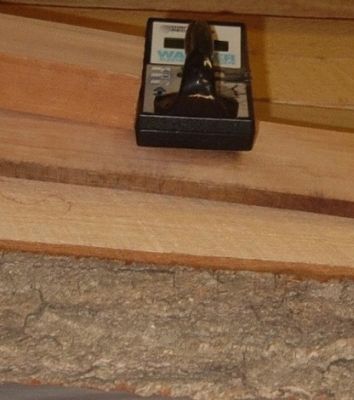What's the Toughest Wood to Dry?
Wood Doctor Gene Wengert lists a few wood species that just love to stay wet. January 27, 2008
Question
What's the most contrary wood you have tried to dry, and why? I have heard bad things about eucalyptus and fruit woods. Pacific madrone is said to start checking as soon as it hears the chainsaw. I'm a wood turner, and I'm tearing my hair out with some pimento wood. Got me to thinking. What makes some woods easier to dry than others? Tangential to radial ratio? Do the cells' properties contribute as well? I have tried DNA, boiling, Anchorseal, plastic bag, paper bag; no success with any of these. Have not tried microwave. My next attempt will be to turn thin, green, and just let it go off. Sometimes you have to let the wood win!
Forum Responses
(Sawing and Drying Forum)
From contributor D:
If I may give my two cents, red beech (a Nothofagus) from New Zealand was the hardest wood for me to dry. The cell walls are very thick and pits, pores, vessels are very small. It is very hard for the water to find a way out. But on the other hand, water can't get back in once it is dry. Some Eucalyptus species are easy, but some others are very tough. One is difficult because the early wood dries extremely easily while the late wood doesn't want to dry at all.
From Professor Gene Wengert, forum technical advisor:
The hardest to dry is probably South American walnut (Peruvian or Columbian walnut). After a year in the kiln, it was still soaking wet. Some eucalyptus was very prone to checking, along with CA black oak. This means low success. Bacterially infected wood is nearly impossible to dry without quality loss. Thick oak (over 2.5") is nearly impossible to dry, along with beech.
From contributor D:
This image illustrates my point. In a vacuum kiln, it takes 12 days to dry the 12/4 red oak on the bottom. It also takes 12 days to dry the red beech on top of the red oak which was only 4/4 before surfacing. The 8/4 red beech on the left takes a whopping 24 days.

Gene, on my list of trial species coming up is one called nogal (Peruvian walnut). Sounds like I need to be careful with this one.
From Professor Gene Wengert, forum technical advisor:
Some nogal is from Mexico and is okay. Peruvian (Juglans neotropica) walnut was the bad stuff, especially 2" and thicker.
From contributor W:
I've been soaking turnings in denatured alcohol and it seems to help a lot. Something about the alcohol binding with the intercellular water and evaporating quickly once removed from the dip. I do a fair amount of madrone and this helps a lot with the checking but not the warping. Seems to dull the colors a bit, as it probably is taking out the natural oils, but all in all I've had good results. I bought at five gallon pail of alcohol and put it into a food safe plastic barrel with removable airtight lid. This is enough to totally submerge a 6" deep turning which I leave in the liquid for roughly 24 hours. We're still talking several weeks for drying, but not months.
From the original questioner:
I have tried the alcohol. That was the DNA reference in my post. Not much help. But thanks!
From contributor A:
Black locust has been bad for me (air drying).
